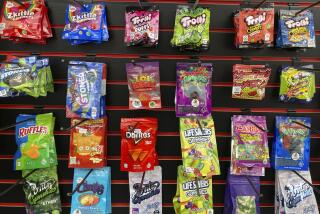Smoking, Illegal Drug Use Still Rising Among Teens, National Survey Shows : Health: Study of 50,000 high school students finds nearly half have used illicit substance at least once. ‘We have a generation at risk,’ Shalala declares.
- Share via
WASHINGTON — More teenagers began smoking cigarettes and using illegal drugs this year, continuing a disturbing trend that began in 1991, according to a major federal study released Friday of substance abuse among high school students.
Cigarette smoking was up among students in 8th, 10th and 12th grades, as was the use of marijuana--use of which showed the sharpest increase among illegal drugs--LSD, other hallucinogens, amphetamines, stimulants and inhalants.
The use of cocaine, including crack cocaine, continued a gradual upward climb, although the one-year changes were not statistically significant, the report said.
Heroin use, while quite low compared to that of other drugs, showed increases among all three grades and was two to three times higher than several years ago, the report said.
Alcohol use remained stable, but nevertheless was the most popular drug among teenagers, with nearly 81% reporting that they had tried drinking alcohol at some point in their lives.
“Your children are at risk,” Health and Human Services Secretary Donna Shalala warned at a news conference. “We have a generation at risk.”
The report, which was conducted by the University of Michigan and funded by the federal government’s National Institute on Drug Abuse, involved 50,000 students in more than 400 public and private secondary schools. The survey has been conducted annually for 21 years, and it is regarded as a major barometer of drug use trends among young people.
Clinton administration officials and Republicans on Capitol Hill used the troubling statistics to trade heated attacks about who is to blame and what needs to be done.
Shalala and Lee P. Brown, outgoing director of the White House Office of National Drug Control Policy, denounced proposed GOP spending cuts in drug abuse programs, saying that the congressional leadership is “playing politics with the lives of American children.”
They also called for increased support for the administration’s controversial proposals to curb tobacco access and advertising geared to young people.
“If Congress would only look at the results . . . [it] would join President Clinton’s campaign to save our children by fully funding effective drug education and treatment programs,” Brown said.
But Sen. Orrin G. Hatch (R-Utah), chairman of the Senate Judiciary Committee, faulted the administration’s “ineffectual leadership” and “a strategy centered around trying to rehabilitate hard-core addicts” for the continuing upward patterns.
Hatch, who has scheduled a hearing Tuesday on drug use among youth, added: “It is time the administration adopted a balanced strategy that makes room for target prevention and treatment without cutting law enforcement and interdiction.”
Smoking among 8th and 10th graders has increased by one-third since 1991 and has risen by one-fifth among high school seniors since 1992, the study said.
The proportion of 8th graders using illicit drugs in 1995 has almost doubled in the last four years. Since 1992, it has jumped by nearly two-thirds among 10th graders and by nearly half among seniors.
According to the survey, 48.4% of high school seniors had used an illicit drug at least once in their lives--”an unacceptably high level,” Shalala said--but still far below the peak of 65.6% reported in 1981.
Marijuana use increased at all three grade levels. It rose more than 2 1/2 times its 1991 level among 8th graders (from 6% in 1991 to 16% in 1995), nearly doubled since 1992 among 10th graders (from 15%, a low point, to 29%), and has increased by more than half among seniors since 1992 (from 22%, also a low point, to 35%).
*
Rates of cigarette smoking increased among high school seniors, with 64.2% reporting that they had tried cigarettes at some point in their lives, an increase from 62% a year ago.
The rate of alcohol use among seniors remained high, at 80.7%
Lloyd D. Johnston, the University of Michigan researcher who conducted the study, attributed the trends to numerous factors, among them a decrease in the perceived dangers of drug use, the entertainment industry’s depictions of drug use as glamorous, ambivalence on the part of parents--many of whom were themselves drug users in the 1970s--and a phenomenon he called “generational forgetting.”
“New classes of young people are replacing previous ones who knew more about drugs and their adverse effects,” he said.
“Teens from a decade ago knew more about drugs because there were more people around them who were users and they could observe the effects of drug use first hand or, in the case of public figures, in the media,” Johnston said. “They were also hearing a lot more about drugs from the news and through public service announcements--today’s teens know less than the teens they replaced. And the lessons [of the consequences of drug abuse] are not being passed on by siblings.”
*
Also, “parents of a decade ago may have been more likely than today’s parents to talk to their children about drugs, because today’s parents actually used drugs when they were teens and may feel hypocritical telling their own teens not to use,” he said.
He said that teenagers also are encouraged by “rap, grunge and rock bands” that “now have marijuana and other drug themes in their lyrics, and display their pro-drug leanings at rock concerts.”
He and other officials blamed advertising targeted to teenagers, among other things, for the continuing upsurge in smoking and the ease with which young people currently can obtain cigarettes.
“Cigarettes are readily available to under-age youngsters,” Johnston said. Moreover, “it’s virtually impossible to ignore the advertising and promotion of cigarettes, when these activities are as massive and pervasive as they are.”
The administration has proposed severe restrictions on teens’ access to cigarettes, as well as sharp curbs on industry advertising.
But Walker Merryman, vice president of the Tobacco Institute, noting that illegal drug use has increased along with smoking, remarked:
“I can’t remember the last time I saw a billboard advertising marijuana. And there are laws on the books with very stringent penalties attached for buying and using illegal drugs which also, apparently, have not stemmed that tide.”
More to Read
Sign up for Essential California
The most important California stories and recommendations in your inbox every morning.
You may occasionally receive promotional content from the Los Angeles Times.













